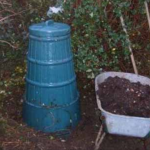Recycling is not just for kitchen waste, it is also something that can be implemented outdoors. Remember that one man’s waste is another man’s (or woman’s) treasure.
The compost heap is an obvious method of recycling raw foods, hedge trimming etc. Avoid using cooked foods in your compost or you’ll end up encouraging four legged tourists into your garden. If you want to go somewhat towards composting without the bother of a full compost heap (though if done properly, it really should not be a bother) collect banana skins, tea and egg shells. These are high in potash ( important for flowering) and can be dug into your soil un-rotted. A grass heap is not a compost heap (compost grass separately) and will take longer to rot down properly.
Aside from composting, there are other methods of re – using materials in your garden. I have for instance, used slates, left over when my house was being built, to form seating areas. Dress these areas with seating constructed using recycled timber and you have very effective outdoor rooms. Old window sills make great seats while chimney pots make very interesting planters. Speaking of planters, I have used a concrete drainage pipe ( left over from a time when I had to drain my site ) filled with soil, to grow strawberries in. Old windows form a cold frame ( for seed sowing etc ) in my vegetable plot, while stripped down timbers form an obelisk (climbing support) for Rosa Sanders White in the same kitchen garden area.
The forged gates of times past were, in my opinion, an art form. Because they are ‘old’, many people have no meas on these gates but I love them and the sense of mystery that they create. What is behind the garden gate? Rather than discard old gates, I have used them throughout my garden for security and also as features. Some are painted green and others are painted red… all for effect.
Have you heard the saying money for old rope? Well, I don’t about money but ‘old rope’ is something that I do know about. Ropes strung between 6’ high timber posts form very effective archways. Train climbers such as Lonicera Halliana, Lonicera Serotina or Rosa New Dawn onto these posts and allow them to trail over the ropes, creating a necklace of colour.
Suppress weeds by covering the soil between plants with layers of newspaper (no glossies please, as these are toxic) which in turn can be surfaced with bark mulch ( I prefer fine grade mulch ) or pebbles.
Waste not, want not in your garden!
Happy Gardening!
Anne.
Garden Checklist.
- Remove rose suckers.
- Continue clipping hedges.
- Feed your lawns and treat weeds.
- Feed shrubs with a general fertiliser.
- Spray apple trees against scab.
- Thin out vegetable seedlings.
- Apply shading in greenhouses and conservatories.
- Re -pot house plants.
- Remove side shoots from tomato plants.
- Plant summer bedding plants.
- Sow wallflower seeds for next year.
- Sow winter cabbage seeds.
- Spray roses.
- Kill moss in lawns using Lawn Gold.
- Prune spring flowering shrubs.




